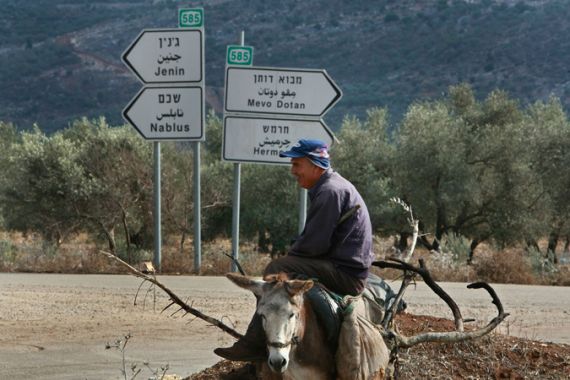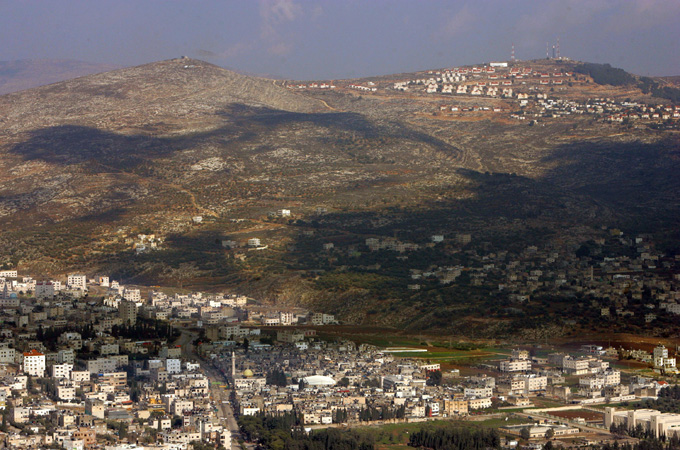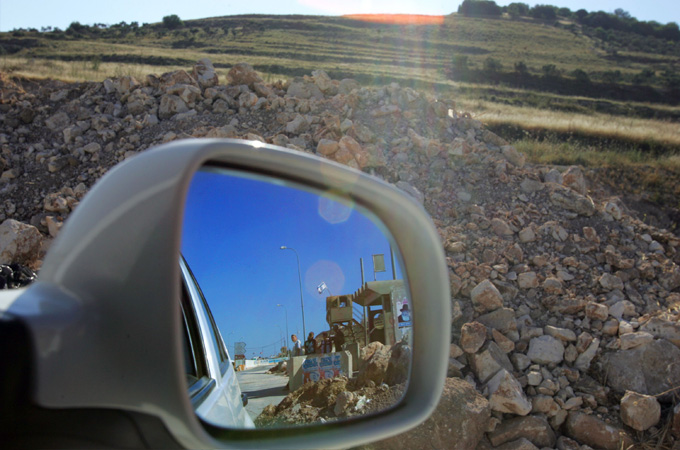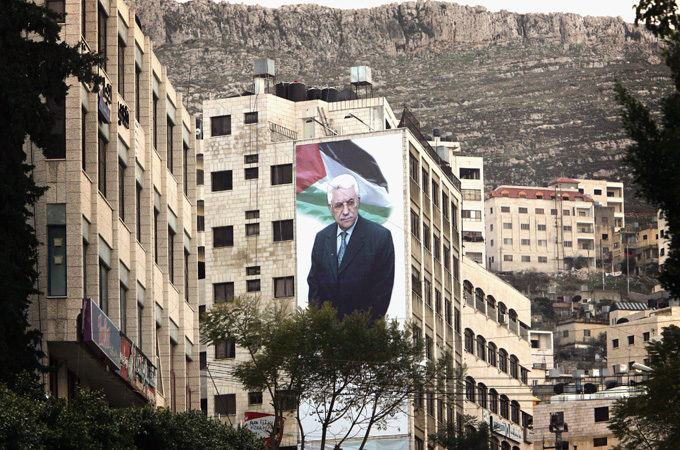Too late for two states
Palestinians say there can be no meaningful resistance as long as their leadership remains divided.

 |
| The people of Nablus, squeezed between towers, checkpoints and red-topped Jew-only housing, say it is too late for a two-state solution to the Israeli-Palestinian conflict [GALLO/GETTY] |
Nablus is built over deep wells on the narrow valley floor between Mount Jarizeem and Mount Aybaal. Its alleyways brim with ground coffee and spices, abrupt wafts of aniseed, plus honied tobacco bubbling from the argilehs, meat vaporising on the grills, traffic fumes, baking odours, pavement rubbish and dust. By day there is plenty of friendly Arab noise; by night barks and cock crows take over.
Although it is a city of over 130,000, everybody seems to know everybody else. Deeper than that, there is a connecting air of solidarity.
The intricate Old City, and the view of the ochre mountainside, reminded me of Damascus. In fact, Nablus used to be known as Little Damascus. Before Messrs. Sykes, Picot and Balfour chopped up the world, there was a trade route from Nablus (the West Bank) via Irbid (Jordan) to Damascus (Syria). Nabulsis and Damascenes intermarried. In Syria today the famous sweet knafeh is known simply as nabulsiyeh, the Nablus thing.
Nablus is also famed for its olive oil soap. Although local bedazzlement by ‘modern’ products and (mainly) the obstructions of Israeli occupation have shrunk the industry, factories still operate in the Old City, sourcing their oil from the semi-besieged villages in the nearby hills.
These days life is a little easier than it has been. Palestinians can get to Ramallah fairly fast. They cannot get to Jerusalem, Gaza or Haifa, but they can benefit from some of the European Union/Palestinian Authority cash sloshing around if they are lucky. They can even drive up to the Sama Nablus viewpoint and drink tea without being shot at from the military base above.
But the Nabulsis remain surrounded; they become moreso every day. The Samaritan village up the hill is closed off (the Samaritans, who are Palestinians, are allowed through the checkpoint to work or school in Nablus). Iraq Burin, a nearby mountaintop village, suffers constant land theft as well as physical attacks by settlers and soldiers. In March, two village teenagers were murdered.
Forbidden Jerusalem
On every hilltop, there is a Jewish settlement.
Near Nabi Saleh in the Ramallah area I saw a settlement – caravans, concrete foundations and fenced-off farmland – constructed during the recent ‘freeze’. While I was in Palestine the ‘freeze’ thawed entirely, sparking a rush of new building as well as some orgiastic orchard-burning.
Half of Nabi Saleh’s agricultural land and now its agricultural water supply have been stolen by armed men from the neighbouring Halamish colony.
In the Salfit region, the Jewish settlement of Ariel cuts the West Bank into south and north. With its own university and theatre complex, the settlement constitutes a veritable city.
The settlements are linked by gleaming highways to Jerusalem and Tel Aviv. But these roads are for Jews only. Palestinian roads access only segments of the land, and are controlled by checkpoints and ditches.
Signs alongside these roads indicate Jewish settlements but not Palestinian towns. Forbidden Jerusalem is signposted in Arabic by the Hebrew name “Urushaleem,” and only between brackets as “al-Quds” – its ancient and contemporary Arab name.
Mountain of Fire
 |
| Palestinian roads only access segments of the land and are controlled by checkpoints [GALLO/GETTY] |
That is the situation, and for now the Nabulsis bear up quietly. Examples of what will happen when they next make a noise are not only delivered across the airwaves from Gaza but are immediately at hand, embedded in the structure of the city itself.
There are bullet holes in the ornamental windows of the Yasmeen Hotel, scars of Israel’s re-occupation of the city centre in 2002, when at least 80 Palestinians were killed and tens of historic buildings were destroyed, including ancient mosques and an Orthodox church.
There are the emptied ruins of entire blocks exploded by F16s. There is a memorial plaque at the site of a home which was bulldozed with a whole family trapped inside. Eight people were murdered there, nine if you count the foetus in the womb of Nabila Shu’bi.
Popularly known as Jabal an-Naar, the Mountain of Fire, the Nablus area has lost 1,600 martyrs in the last decade. Each quarter has a plaque listing local names, and the faces of fighters adorn the Old City walls.
In a strange echo of these posters, and what felt like proof that death’s memory is inescapable in Nablus, an icon in the restored Byzantine-Crusader church at Joseph’s Well (where Jesus revealed himself as messiah to a Samaritan) shows Archimandrite Philoumenos Khassapis being hacked 36 times by the axe of a fanatical settler in 1979.
Greek tourists and Palestinian Christians pray at the Archimandrite’s shrine.
The family of martyrs
After one Friday’s prayers I visited the grave of a friend’s mother, Shaden al-Saleh. Shaden was a teacher and community organiser. She was executed by Israeli soldiers while embroidering on the step at home. After we had paid our respects, her son and I brushed the needles from the grave of Jihad al-Alul, who was shot in the head on the first day of the Second Intifada, ten years ago.
The 20-year-old had been part of an unarmed crowd confronting soldiers at the Hawwara checkpoint which blocks the city’s southern exit. As we swept the needles from Jihad’s memorial we chatted with Abu Fadi, whose two martyred sons are nearby. A warm, mournful man, Abu Fadi has made a garden of their tombs. My friend knows him well, as he knows all the families who visit these graves. He says that when his mother died he became part of the great family of the martyrs.
I had come to Nablus to teach a creative writing course. For one exercise I asked the students to write about a moment connecting a character to history. One young woman wrote about her younger self clutching the radio as bombs gobbled surrounding buildings. One wrote about her big brother, not the story of his murder but the story of her finding out. Another wrote about her 12-year-old nephew’s funeral. He had been shot in an empty street. His aunt choked with tears as she read out her text.
I feared that I had gone too far, imposing on them a subject they must be constantly picking at. But the class reassured me. One used the word ‘therapeutic’. “We never normally have an opportunity to talk about these things,” she said.
Dual occupation
One reason for the silence is the censoring chill cast over public discourse by the split in Palestinian leadership.
The besieged Hamas government in Gaza rounds up Fatah activists, while the West/Israeli-backed Palestinian Authority (PA) arrests Hamas sympathisers in the West Bank. Six-hundred Nabulsis are currently held in the PA’s Junaid prison.
People speak guardedly in public, as they do in any other Arab police state. But many Palestinians call the current system a dual occupation.
When the Israelis choose to they order the PA police off the streets and then take men from their homes. This happened several times during my visit, always at night – once two brothers were taken from the kiosk at the end of my street.
The people in Balata Camp – a place far more harrowing than the graveyard – told me that the soldiers came in most nights.
The Balata refugees have their own graveyard, containing an absurd proportion of young martyrs. But what is more painful than death in Balata is the caged density of the living – the numbers crammed in narrow rooms, the high ratio of men in wheelchairs, the broken faces of the prematurely aged. These people came from Haifa, Jaffa, Acre. They lived in farms, towns and villages within sight of the sea. Today they are not safe even in their breezeblock cells. During the Intifada Israeli troops used to enter their houses by blowing holes through the walls.
No resistance without unity
 |
| Some argue that there can be no effective resistance without Palestinian unity [GALLO/GETTY] |
I saw Haneen al-Zoabi giving a lecture. She is the knesset member who sailed with the Gaza Flotilla and was so shabbily abused while attempting to give her account of events to Israel’s parliament. In Nablus, she spoke emotionally about the situation of Palestinian-Israelis, the descendants of those few who escaped ethnic cleansing in 1948.
Citizens but not nationals of the state (nationality is for Jews only), Palestinian-Israelis receive a fraction of the services offered to Jews, are forbidden from teaching Palestinian history in schools and are as likely to be victims of land confiscation as fellow Palestinians in the West Bank. Ninety-three per cent of Israel’s land is off-limits to non-Jews and half of Palestinian-Israeli families live below the poverty line.
I heard Jamal Hwayil speak. He was the leader of the Fatah-affiliated al-Aqsa Martyrs Brigade in Jenin at the time of Israel’s 2002 massacre there and now he is an independent member of the Palestinian parliament. He took a clear position on Palestinian division: “Political arrests are wrong. Wrong in Gaza and wrong in the West Bank. Political arrests have no place in a liberation struggle.”
A little later he added: “There can be neither meaningful negotiations nor productive armed resistance so long as the political leadership is divided.”
Sitting next to this veteran of the armed resistance were Ayed Morrar and Muhammad Khatib, leaders of the ‘popular’ or non-violent resistance in Budrus and Bil’in villages respectively. Morrar is the star of the film Budrus, which shows him not only uniting Hamas and Fatah activists in his village, but also mobilising the village’s women, international activists and even some Israelis against the separation wall that is eating away Budrus’ olive orchards. Budrus managed to keep 95 per cent of the threatened land.
From the panel Jamal Hwayil congratulated Morrar for achieving 95 per cent of his immediate objective, but cautioned that the victory was incomplete: five per cent of the land had gone, the wall still stands and the occupation continues.
Hwayil, Morrar and Khatib agreed that armed and unarmed resistance complement each other and that the question of which to employ in any given context was not moral but tactical.
As well as the resisters, there were the sort of people who organised the discussion: articulate, engaged young thinkers analysing the system as apartheid, calling for the system to be replaced by democracy and promoting a Western boycott of Israel as one way to achieve this. Such ideas are growing increasingly influential in civil society, but they have no powerful party to represent them.
West Bank reservations
Meanwhile, as Neta Golan, a West Bank national of Jewish origin, told me: “They’ve made it very easy to get loans. People in Ramallah have bought cars. The rents are sky high. For the next few years a lot of people are just going to be pleased to pay off the loans.”
This is the Tony Blair-Salam Fayyad plan for the West Bank reservations. In the words of political geographer Saed Abu Hijleh the message is “eat, drink, go to the toilet and shut up”.
The landscape tells anybody who lives here, squeezed between towers, checkpoints and red-topped Jew-only housing, that it is far too late for two states.
For the refugees caged in camps, still holding the keys to their destroyed coastal homes, two states never sounded like a solution anyway. Palestine-Israel has always been one country.
From Refaat village I could see Tel Aviv’s towers twinkling against the gathering gloom, not very far away at all. Israel’s rain falls here where I stand, on the first band of hilltops east of the Mediterranean, on the West Bank.
Robin Yassin-Kassab is the author of The Road From Damascus, a novel published by Penguin. He co-edits www.pulsemedia.org and blogs at www.qunfuz.com.
The views expressed in this article are the author’s own and do not necessarily reflect Al Jazeera’s editorial policy.